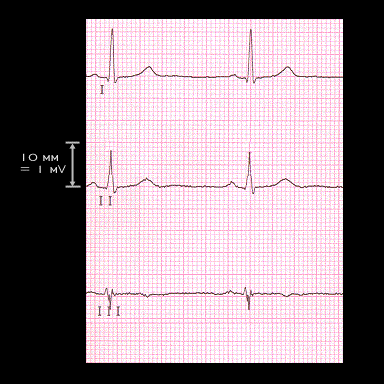
This concept is illustrated in this tracing. Note that the amplitude of the QRS complex in lead I is 11 mm in the positive or upright direction. In lead III, the amplitude of the QRS complex is 3 mm in the negative or inverted direction and in lead II, the QRS amplitude in lead II is 8 mm in the positive or upright direction. You will note that as predicted by Kirkoff's law, the QRS amplitude in lead II equals the sum of the QRS amplitudes in lead I and III, or 11 +(-3) = 8.
Similarly, the P wave amplitude in leaad II (1 mm) equals the sum of P wave amplitudes in lead I (0.5 mm) and lead III (0.5 mm), and the T wave amplitud in lead II (2 mm) equals the sum of the T wave ampitudes in leads I (+2.5 mm) and lead III (-o,5 mm)
